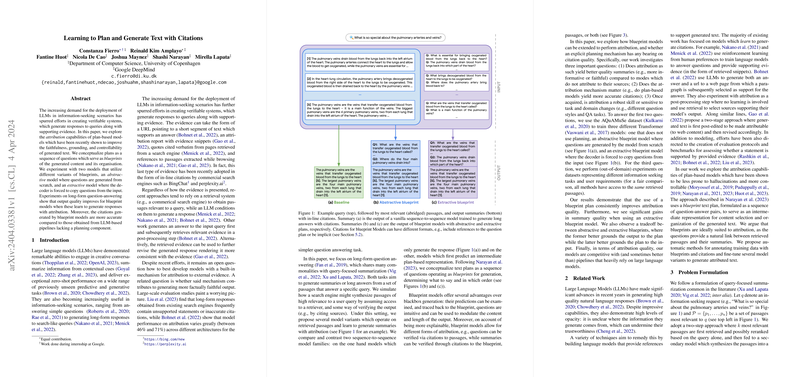Exploring Attribution in Plan-Based Models for Text Generation with Citations
Introduction to Attribution in Text Generation
Recent advancements in generative AI have presented new challenges and opportunities in the development of verifiable systems capable of producing text alongside supporting evidence. This research focuses on enhancing the generation of long-form responses to queries by integrating attribution mechanisms into the plan-based models of text generation.
The Core Challenges
Two primary challenges are addressed:
- Attribution Quality: How can models produce responses with high-quality citations that are factually accurate and faithfully represented?
- Plan-Based Text Generation: How can blueprint plans, conceptualized as sequences of questions, improve the structure, faithfulness, and citation accuracy of the generated content?
Methodology and Models
The paper introduces models based on two blueprint strategies:
- Abstractive Blueprint Models, where generated questions form a structured plan to guide the content generation process.
- Extractive Blueprint Models, which construct blueprints by selecting relevant questions directly from the input data.
Both models were compared against baseline systems without planning components, evaluating their effectiveness in terms of output quality and attribution accuracy.
Key Findings and Results
The research reveals that blueprint models consistently improve both the quality of generated content and the accuracy of citations. Notably, the extractive blueprint model exhibits significant advancements in summary quality, suggesting a robust approach to integrating planning and attribution mechanisms.
Quantitative Analysis shows:
- An improvement in ROUGE-L scores, indicating better content relevance and structure.
- Higher ANLI scores, reflecting enhanced factual consistency and faithfulness.
- Superior attribution quality, as evidenced by improved AutoAIS metrics.
Implications and Future Directions
This paper underscores the potential of blueprint models in fostering more faithful and verifiable text generation systems. The findings suggest that planning mechanisms not only aid in structuring generated content but also play a crucial role in enhancing citation accuracy.
Practical Implications include:
- The utilization of blueprint models in information retrieval and summarization tasks, especially those requiring verifiable sources.
- Improvement in user trust towards AI-generated content through transparent attribution.
Theoretical Implications involve:
- Validation of the hypothesis that explicit content planning can lead to improved generation fidelity and source attribution.
- Demonstration of the transferability of attribution skills across different information-seeking tasks and domains.
Looking ahead, further research could explore the integration of blueprint models with larger and more complex datasets, expanding their applicability and understanding of their limitations. Additionally, future work might delve into the dynamics between different blueprint strategies and their impact on the diversity and comprehensiveness of generated content.
Conclusion
This research marks a significant step towards developing text generation models that not only produce coherent and relevant responses but also attribute their sources accurately. By leveraging blueprint plans, it opens new avenues for improving the reliability and trustworthiness of AI-generated content, addressing critical challenges in the field of generative AI and information verification.
